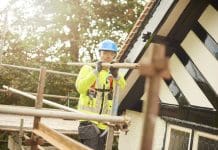As NHBC celebrates its 30th anniversary, Diane Marshall, Head of Technical Services, looks back over the last 30 years, and how the changes implemented by the Housing Standard Review will impact the house building industry…
In 1985, NHBC launched its Building Control service as the UK was on its way to producing record housing levels by the end of the decade. From the very beginning, the service has helped to raise standards of new homes via comprehensive design checks and site inspections and now carries out upwards of 400,000 inspections each year for building control. It has also helped NHBC’s builder customers to build quality homes that comply with the Building Regulations across England and Wales for the hundreds of thousands of new home owners over the last three decades.
Rewind to the mid-80s when NHBC launched its building control in England and Wales, the service was limited to three story houses. However, there have been several significant changes during this time, as the service has developed to cater for a wider range of properties – from single plots, to large scale mixed-use developments, London skyscrapers, landmark commercial projects and even the conversion of the Grade II listed Roald Dahl Museum.
1985 also saw the introduction of NHBC’s innovative Type Approval system. As the name suggests, Type Approvals are a useful tool if builders propose to build standard house types and details. Type Approvals of a repeat design, can helpfully speed up subsequent sites as it will always be accepted by NHBC throughout England and Wales. Recent changes to the Type Approval system now also allow specific Type Approvals for house types used exclusively in England or Wales.
Additionally, Building Regulations have evolved over the years from prescriptive requirements to a more open system of functional requirements which give the designer greater choices. Early involvement of NHBC Building Control in a project therefore allows designers to consult building control professionals on their innovative solutions and ensure that they meet the requirements early on. Another major change was the increase in popularity of timber frame construction in the late 1980s, which has further evolved to a rise in the use of prefabrications and MMCs. As a result, keeping our technical staff up-to-date with regulations is of key importance; the last 30 years has seen an ever increasing rate of change as well as some of the approved documents becoming specialist in nature, such as Approved Document B – fire Safety and L – Conservation of Fuel and Power.
New century, new developments
In 2000, NHBC became the first Building Control body to invest heavily in a state of the art IT system, which made the business paperless and transformed the way the organisation interacted with customers.
New initiatives have continued over the years, with the launch of NHBC’s customer portal to make submission of information even faster, while this year has seen the introduction of a new TechZone, an online technical resource which includes Building Control Plus; a fully interactive platform which includes all Building Regulations and supplementary resources in one place.
Looking ahead, the industry is now in the process of embracing the challenges set by the Housing Standards Review. Earlier this year in March, shortly before the dissolution of Parliament, the then coalition government issued the final results of its wide ranging review of the many statutory and non-statutory standards that house builders were being asked to design and build to. Running to just over 4000 pages of legislation, regulation and guidance, the comprehensive package completely changes the basis for building regulations that have been in place as far back as the 1667 London Building Act, i.e. to set the minimum standards for all new buildings.
The review, which commenced in 2013, was launched as a ‘tidying up’ exercise to deal with ‘complex, overlapping or contradictory housing standards’, replacing over 100 different policies and standards into a single set of national standards, most of which are published in the Building Regulations.
The final results of the review sees the introduction of Optional regulations in Part M – Access and also Part G – Water as well as a new mandatory regulation for all new housing Part Q – Security as well as a National Space Standard which has not been placed in the building regulations.
How will it work?
The system was implemented on October 1st. From this date, Local Planning Authorities’ (LPA) can impose optional higher standards on space, water and access to residential developments in their area provided that they have set policies in their local plan. The ability to impose these standards is dependent on the LPA demonstrating a local need and also the viability of developments if the new higher standard was required.
The developer must then inform their selected building control body (BCB) if an “Optional” requirement has been imposed on their development and it is then the job of the BCB to enforce these as if they were the minimum standard for that development in the usual way.
Guidance for local authorities on how to apply the optional higher standards has been issued to all LPA’s.
So, what are the key areas covered by the new regulations?
Water
Minimum water efficiency standards were introduced into Building Regulations in 2010 and currently require that new homes are designed so that calculated water use is not more than 125 litres/person/day. This minimum standard is to be retained with an optional more conservative standard available locally ‘where there is a clear local need’. The new optional local standard of 110 litres/person/day was introduced on October 1st.
Access
The new 2015 regulations substantially change Approved Document M to allow for new optional access requirements to be available locally. Existing standards are to be consolidated with Lifetime Home Standard being replaced by ‘Category 2 – Accessible and Adaptable Housing’ and Wheelchair Housing Standards to be replaced by ‘Category 3 – Wheelchair User Dwellings in Part M (Access to and use of buildings)’.
Security
A new mandatory security requirement (Part Q) has been introduced for all new dwellings. The new standard intends to introduce a level of consistency across different areas and consolidate around cost effective measures to reduce the incidence of burglary.
Space**
As well as the introduction of a minimum gross internal floor area and built-in storage area dependent on number of bedrooms, the standard will insist that at least one bedroom in a two-bedroom home is a double (or twin) room. Minimum room sizes also apply as well as a minimum floor to ceiling height of 2.3m for at least 75% of the gross internal area.
The new nationally described space standard has not been incorporated into Building Regulations. Instead the standard may be imposed by local planning authorities as a planning condition.
** The Nationally Described Space Standard remains outside of the Building Regulations and where applicable will be enforced by LPA’s.
The future
Having spent the last six months digesting the new regulations and understanding the complexities of what lies ahead, we hope that the industry will adopt the changes relatively seamlessly, but we are here to help builders adapt.
Looking ahead, this landmark year provides an opportunity to think about ways in which NHBC Building Control can further support its builder customers. Needless to say, NHBC Building Control will continue to innovate and support builders and homeowners by providing a rigorous, independent third party check on the design and construction of the UK’s new homes.
For further information about NHBC please visit their website ■
. . . . . . . . . . . . . . . . . . . . . . . . . . . . . . . . . . . . . . . . . . . . . . .
Diane Marshall
Head of Technical Services
NHBC
Tel: 0800 035 6422













![[VIDEO]What to expect when you’re inspecting: Using DorTrak for fire door inspections](https://www.pbctoday.co.uk/news/wp-content/uploads/2025/02/maxresdefault-218x150.jpg)